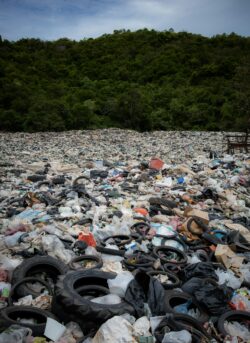PFAS Regulatory Updates to Address Invisible Hazards
In environmental protection, the battle against invisible threats often goes unnoticed by the public eye. Yet, recent PFAS regulatory updates presented by the U.S. Environmental Protection Agency (USEPA) have brought a crucial contender into the spotlight: per- and polyfluoroalkyl substances (PFAS). These synthetic chemicals, omnipresent in our daily lives—from non-stick cookware to firefighting foams—have raised concerns due to their environmental persistence and potential health risks.
 With the USEPA’s recent Publicly Owned Treatment Works (POTW) Influent Study under Effluent Guidelines Program Plan 15, Toxic Substances Control Act (TSCA) PFAS reporting requirements, proposed rule under the Resource Conservation and Recovery Act (RCRA), the release of two PFAS testing methods, understanding PFAS has never been more critical.
With the USEPA’s recent Publicly Owned Treatment Works (POTW) Influent Study under Effluent Guidelines Program Plan 15, Toxic Substances Control Act (TSCA) PFAS reporting requirements, proposed rule under the Resource Conservation and Recovery Act (RCRA), the release of two PFAS testing methods, understanding PFAS has never been more critical.
At EnviroScience, we are at the forefront of this emerging field, bolstered by the expertise of our Senior Environmental Toxicologist, Kevin Custer, Ph.D.
Understanding PFAS in Layman’s Terms
 Imagine chemical substances so persistent that they don’t break down in nature—that’s PFAS for you. These PFAS chemicals are unique due to their carbon-fluorine bonds. They are found in countless consumer products and are known for their oil, water, grease, and heat-resistant properties.
Imagine chemical substances so persistent that they don’t break down in nature—that’s PFAS for you. These PFAS chemicals are unique due to their carbon-fluorine bonds. They are found in countless consumer products and are known for their oil, water, grease, and heat-resistant properties.
These “Forever Chemicals” have a knack for sticking around in our environment and bodies, causing adverse human health effects such as liver and kidney cancers, as well as thyroid, reproductive, and developmental effects.
Recognizing the risks, the USEPA is taking steps toward regulatory updates to safeguard our water and soil from contamination.
Enter EnviroScience PFAS Expert Dr. Kevin Custer
 EnviroScience prides itself on having a team of dedicated experts like Dr. Kevin Custer, an aquatic ecotoxicologist and a PFAS subject matter expert. Dr. Custer’s career journey from the U.S. Department of Agriculture-Natural Resources Conservation Service to EnviroScience showcases a deep commitment to understanding and mitigating environmental contaminants.
EnviroScience prides itself on having a team of dedicated experts like Dr. Kevin Custer, an aquatic ecotoxicologist and a PFAS subject matter expert. Dr. Custer’s career journey from the U.S. Department of Agriculture-Natural Resources Conservation Service to EnviroScience showcases a deep commitment to understanding and mitigating environmental contaminants.
Dr. Custer’s work—particularly in aquatic environments—positions EnviroScience uniquely to address the challenges posed by PFAS through comprehensive field sampling, data analysis, and compliance strategies.
What the Newly Proposed PFAS Regulatory Updates Mean
Recently, the USEPA entered into the Federal Register its intent to submit an Information Collection Request to the Office of Management Budget for the POTW Influent PFAS Study under Effluent Guidelines Program Plan 15. Under the POTW Influent PFAS Study, the USEPA will perform a two-phased approach to sample 200-300 of the highest flow POTWs and up to 2000 Industrial Users (IUs) in the U.S. The study will test the POTW influent, effluent, sludge/biosolids, and IU effluent using Method 1633 and Method 1621. The public comment period closes on May 28, 2024.
 The USEPA has updated the definition of a PFAS chemical substance in TSCA Section 8(a)(7), and the chemical substance must meet one of three defined PFAS chemical structural definitions found in this rule. These PFAS reporting requirements under this rule are for TSCA chemical substances that were manufactured going back to 2011.
The USEPA has updated the definition of a PFAS chemical substance in TSCA Section 8(a)(7), and the chemical substance must meet one of three defined PFAS chemical structural definitions found in this rule. These PFAS reporting requirements under this rule are for TSCA chemical substances that were manufactured going back to 2011.
The USEPA has identified 1,462 PFAS from the known TSCA universe that have been manufactured or in commerce since 2006, including any chemicals submitted under the USEPA’s TSCA New Chemicals Program. There are specific entities that are required to report under TSCA. If an entity falls under TSCA reporting requirements, there are a couple of important items to note under this rule: no reporter exemptions and no minimum volume/concentration exemptions.
The USEPA proposed rulemaking to designate nine PFAS under RCRA because studies are showing toxic and adverse health effects on humans and animals from PFAS exposures. This proposed rule will potentially affect hazardous waste treatment, storage, and disposal facilities with solid waste management units. The public comment period closes on April 8, 2024, so watch for updates as the USEPA moves this proposed rule forward.
The USEPA’s actions signal a shift towards stricter oversight and management of PFAS. This means adapting to new testing protocols and potentially reevaluating waste management practices for industries and municipalities. The release of Method 1633 allows for the quantification of up to 40 PFAS compounds in a host of environmental matrices. While Method 1621 serves as a screening tool, this method indicates if organofluorines (carbon-fluorine bonds) are present in water and wastewater. Together, these methods guide stakeholders in identifying and addressing PFAS presence.
EnviroScience’s Role in Addressing PFAS Regulatory Updates
EnviroScience remains at the cutting edge of environmental consulting as regulations evolve, equipped to navigate the complexities of PFAS detection, field sampling, data analysis, and compliance.

Our capabilities extend beyond testing, encompassing a holistic approach to environmental challenges that leverages our team’s extensive knowledge and multidisciplinary expertise. Whether it’s conducting detailed analyses for water and wastewater or developing strategies for environmental compliance, EnviroScience offers a robust suite of services tailored to meet the needs of our clients in this new regulatory landscape.
How EnviroScience Can Help Your Project’s PFAS Challenges

The fight against PFAS pollution is a testament to the ongoing efforts to protect our planet and public health. With the USEPA’s recent regulatory updates and the expertise of our team’s professionals, EnviroScience stands ready to lead the charge. We are not just responding to environmental challenges; we’re anticipating them, ensuring our clients and communities can confidently navigate the future of environmental stewardship.
Visit our PFAS Sampling & Mitigation Services webpage for more information on how our robust team of experts can help identify solutions to your projects where PFAS are an area of concern.
Few environmental firms in the country retain EnviroScience’s degree of scientific know-how, talent, and capability under one roof. The diverse backgrounds of our biologists, environmental engineers, scientists, and divers enable us to provide comprehensive in-house services and an integrated approach to solving environmental challenges—saving clients time, reducing costs, and ensuring high-quality results.
Our client guarantee is to provide “Excellence in Any Environment,” meaning no matter what we do, we will deliver on our Core Values of respect, client advocacy, quality work, accountability, teamwork, and safety. EnviroScience was created with the concept that we could solve complex problems by empowering great people. This concept still holds true today as our scientists explore the latest environmental legislation and regulations and incorporate the most up-to-date technology to gather and report data.
EnviroScience expertise includes but is not limited to aquatic surveys (including macroinvertebrate surveys and biological assessments); ecological restoration; ecological services (including impact assessments, invasive species control, and water quality monitoring); emergency response; engineering and compliance services; endangered mussel surveys; laboratory and analysis; stormwater management; threatened and endangered species; and wetlands and streams (including delineation and mitigation). Further, EnviroScience is one of the few biological firms in the country that is a general member of the Association of Diving Contractors International (ADCI) and offers full-service commercial diving services.